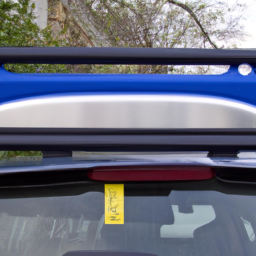Have you ever wondered how much weight crossbars can hold? Whether you’re planning to transport heavy equipment on your car’s roof or considering using crossbars for additional storage, understanding their weight capacity is crucial. In this article, we will explore the factors that determine the weight limit of crossbars and provide you with useful insights to ensure safe and efficient use. So, let’s get started and find out just how much weight those crossbars can handle!
What are crossbars?
Crossbars, also known as roof racks or roof rails, are essential components of a vehicle’s roof system. They are usually mounted on the roof of a car or SUV to provide a sturdy and secure platform for carrying various items such as bicycles, kayaks, roof boxes, skis, snowboards, surfboards, and other large or bulky equipment.
Definition
Crossbars are horizontal bars that span the width of a vehicle’s roof. They can be attached to the existing roof rails or directly to the roof itself using a mounting system. These bars can be made of different materials such as aluminum, steel, or composite materials and come in various shapes, including square, round, and aerodynamic (aero) designs.
Function
The main function of crossbars is to create a stable and secure base for transporting items on the roof of a vehicle. They provide a strong support structure to hold heavy loads and distribute the weight evenly across the roof. Crossbars also allow for easy attachment of accessories such as bike racks, kayak carriers, and cargo boxes, making it convenient to transport a wide range of gear and equipment.
Factors affecting weight capacity
Several factors influence the weight capacity of crossbars. Understanding these factors is crucial to ensure that you don’t exceed the limit and compromise safety.
Material
The material of crossbars plays a significant role in determining their weight capacity. Generally, crossbars made of aluminum are lighter but still offer high strength, making them a popular choice among car owners. Steel crossbars are more robust but tend to be heavier. Composite materials offer a balance between strength and weight, but their weight capacities may vary depending on the specific composition.
Design
The design of crossbars, including their shape and profile, can affect their weight capacity. Square bars, with their simple and box-like structure, typically have higher weight capacities compared to round or aero bars. Aero bars, on the other hand, are designed to reduce wind drag and noise, but they may have slightly lower weight capacities due to their streamlined shape.
Length
The length of crossbars also impacts their weight capacity. Longer crossbars provide more space for distributing the load, which can increase the weight capacity. However, it’s essential to consider the specific limitations of your vehicle’s roof and ensure that longer crossbars do not exceed those limits.
Mounting System
The type of mounting system used to attach the crossbars to your vehicle can affect their weight capacity. Some mounting systems provide a more secure and robust connection, allowing for higher weight capacities. It’s important to choose a mounting system that is compatible with your vehicle and ensures a strong attachment to avoid any accidents or damage.
Types of crossbars
Crossbars come in different shapes and designs to cater to various vehicle models and individual preferences. Understanding the different types can help you choose the one that best suits your needs.
Square bars
Square bars are the most traditional and commonly used type of crossbars. They have a simple, square-shaped profile and offer excellent weight capacity. Square bars are known for their versatility and compatibility with a wide range of accessories, making them a popular choice among car owners.
Round bars
Round bars feature a circular profile and are a more aerodynamic option compared to square bars. While they may have slightly lower weight capacities, round bars are generally quieter and more fuel-efficient due to their streamlined design. They are a great option if you prioritize fuel efficiency and reduced wind noise.
Aero bars
Aero bars, also known as elliptical or wing-shaped bars, are designed to reduce wind resistance and improve aerodynamics. They have a sleek and modern appearance that complements the overall look of modern vehicles. Aero bars offer excellent fuel efficiency, reduced wind noise, and improved handling at high speeds. However, they may have slightly lower weight capacities compared to square or round bars.
Weight capacity of square bars
Square bars are known for their impressive weight capacity, making them suitable for carrying heavier loads on your vehicle’s roof.
Common weight ratings
The weight capacity of square bars can vary depending on their material, design, and length. However, a standard square bar can typically support loads ranging from 150 pounds to 250 pounds. Some heavy-duty square bars can even handle weights up to 500 pounds or more, depending on the specific model and manufacturer.
Determining factors
The weight capacity of square bars is influenced by several factors, including their material and design. Square bars made of aluminum are generally lighter but still offer high weight capacities. The shape and profile of square bars also contribute to their weight capacity, with thicker and sturdier bars usually having higher weight ratings.
Weight capacity of round bars
Round bars may have slightly lower weight capacities compared to square bars, but they still offer sufficient strength for most rooftop cargo needs.
Common weight ratings
Standard round bars typically have weight capacities ranging from 100 pounds to 200 pounds, depending on their material, design, and length. Heavy-duty round bars may have higher weight ratings, reaching up to 400 pounds or more.
Determining factors
The weight capacity of round bars is determined by factors such as the material used, the thickness of the bars, and the specific design. Round bars made of high-quality steel or durable aluminum alloys can provide excellent strength and weight capacity. Additionally, longer round bars may have higher weight capacities due to their increased surface area for load distribution.
Weight capacity of aero bars
Aero bars, with their sleek and aerodynamic design, prioritize reduced wind resistance and improved fuel efficiency over maximum weight capacity.
Common weight ratings
Aero bars typically have weight capacities ranging from 100 pounds to 200 pounds, depending on the specific model and manufacturer. They are designed to handle most common cargo needs, such as carrying bicycles, kayaks, or roof boxes.
Determining factors
The weight capacity of aero bars is influenced by factors such as their material, shape, and overall design. While they may have slightly lower weight ratings compared to square or round bars, aero bars offer excellent aerodynamics and fuel efficiency. Their streamlined shape reduces wind resistance, making them ideal for highway driving and reducing drag noise.
Specific vehicle limitations
It’s important to consider the weight limits specific to your vehicle when using crossbars. Each vehicle has its own maximum roof weight limit, and exceeding it can lead to structural damage or even accidents.
Roof weight limits
Consult your vehicle’s owner’s manual or contact the manufacturer to determine the maximum roof weight limit. This limit includes the weight of the crossbars themselves and any cargo or accessories you plan to carry on the roof. Exceeding this limit can cause damage to the roof structure and compromise the stability and handling of your vehicle.
Manufacturer recommendations
In addition to the roof weight limit, manufacturers may provide specific recommendations for crossbar weight capacities. It’s crucial to follow these recommendations to ensure your safety and prevent any warranty issues. Manufacturers consider various factors when determining weight capacities, including the design, material, and mounting system of the crossbars.
Using crossbars for different purposes
Crossbars offer versatility and can be used to transport a variety of items on your vehicle’s roof. Here are some common uses for crossbars:
Carrying bicycles
Crossbars provide a secure and convenient way to transport bicycles on your vehicle. Bike racks can easily be attached to the crossbars, allowing you to safely transport your bikes without taking up valuable space inside the car. Make sure to choose a bike rack that is compatible with your crossbars and can support the weight of your bikes.
Transporting kayaks/canoes
If you enjoy water sports, crossbars are essential for safely transporting kayaks or canoes. Specialized kayak carriers can be attached to the crossbars, providing a stable and secure platform for your watercraft. Make sure to properly secure your kayak or canoe using straps and tie-downs to prevent any movement during transit.
Carrying roof boxes
Roof boxes, also known as cargo boxes or rooftop carriers, are a popular accessory for increasing your vehicle’s storage capacity. Crossbars provide a solid foundation for attaching and securing roof boxes. They allow you to carry camping gear, luggage, sports equipment, and other bulky items without sacrificing interior space. Ensure that the weight of the roof box and its contents does not exceed the weight capacity of your crossbars.
Transporting skis/snowboards
Crossbars are a great solution for transporting skis and snowboards during winter sports seasons. Ski racks and snowboard carriers can be easily mounted onto the crossbars, providing a safe and secure means of transporting your winter gear. Make sure to choose a rack or carrier that fits your specific needs and can accommodate the number of skis or snowboards you plan to carry.
Carrying surfboards
Surfboards can be safely transported on crossbars using surfboard racks or pads. These accessories mount securely to the crossbars and provide a stable platform for your surfboard. It’s important to use appropriate padding and secure your surfboard properly to prevent any damage during transit.
Safety precautions
While crossbars offer a convenient way to transport various items on your vehicle’s roof, it’s essential to follow safety precautions to ensure a safe and worry-free journey.
Exceeding weight limits
Never exceed the weight limits specified by the manufacturer for your crossbars and your vehicle’s roof. Exceeding these limits can lead to structural damage, instability, and potential accidents. Remember to consider the weight of the crossbars themselves, any accessories you attach, and the weight of the cargo you intend to transport.
Evenly distributing weight
When loading items onto your crossbars, make sure to distribute the weight evenly across the roof. This helps maintain stability and prevents overloading particular areas. Uneven weight distribution can affect the handling and performance of your vehicle and potentially cause damage to the roof or crossbars.
Regular inspections
Regularly inspect your crossbars, mounting system, and any accessories for signs of wear and tear. Check for loose or damaged components, rust, or any other issues that could compromise the safety and integrity of the system. Ensure that all attachments, including bike racks, kayak carriers, or cargo boxes, are properly secured and tightened before each trip.
Conclusion
Crossbars are essential accessories for maximizing your vehicle’s storage capacity and enabling you to transport a wide variety of items on your roof. By understanding the different types of crossbars, their weight capacities, and the factors that influence them, you can make informed decisions about which type of crossbars best suits your needs. Remember to always consider the weight limits specific to your vehicle, follow manufacturer recommendations, and prioritize safety by evenly distributing weight and conducting regular inspections. With the right crossbars and proper precautions, you can enjoy the convenience and versatility of transporting your gear securely and safely.


